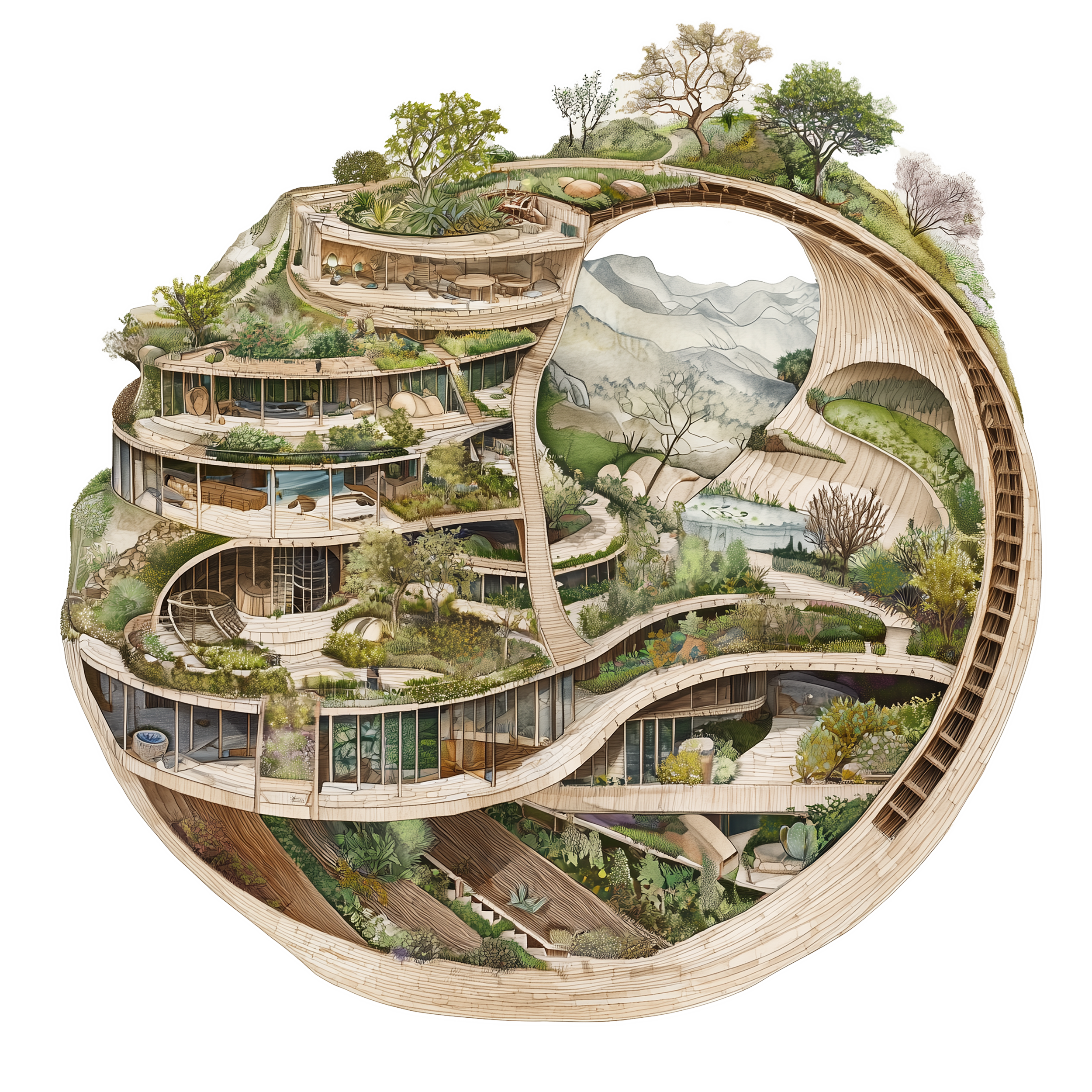Skye Ruozzi
Architect weaving ecology, craft, and code into regenerative spaces.
What is Bioconstruction?
Constructing Shelters That Nourish People and Planet
Bioconstruction recognizes that our shelters should be healthy for both people and the planet. It's an approach to building that emphasizes connection to materials and their life cycles, using bio-based resources to create structures with significantly lower carbon footprints.
The Bioconstruction Ethos
Thinking in Deep Time
Bioconstruction means reasoning in seasons, cycles, and generations. It's a conscious response to extractive building practices, moving beyond sustainability toward active repair and replenishment.
Connection Through Materials
We build with awareness of where materials come from and where they'll return. This connection transforms building from mere construction into a relationship with the living world.
Reciprocity, Language, Memory
Each building becomes part of a place's story, honoring local wisdom while creating new memories through collaborative, mindful creation.
Why "Bioconstruction" Over "Natural Building"?
Yes, "bioconstruction" is essentially the same practice as "natural building," but the term carries important significance:
Global Alignment
"Bioconstruction" (bioconstrucción in Spanish, bioconstruction in French, bioconstrução in Portuguese) aligns our terminology with the global majority. This recognizes that these practices have existed uninterrupted in many cultures for generations.
Intentional Language
While both terms contain the same number of syllables, "bioconstruction" packs a purposeful punch—emphasizing the biological, living systems approach at its core.
Cultural Respect
Using this terminology acknowledges that the bio-based materials movement in the United States is rediscovering what many cultures have known and practiced for centuries.
Core Methods & Materials
informed by The Last Straw magazine. Bioconstruction utilizes a palette of materials that are healthful, low in embodied carbon, and often carbon-sequestering. These materials are categorized by their composition and behavior, helping us make informed choices for each unique project.
Earth-based Methods
Earth-based materials are primarily mineral-based (dirt) and are known for their high thermal mass, which provides excellent "time lag"—meaning they absorb heat slowly and release it slowly, helping to regulate indoor temperatures. They generally have low insulative R-values but require very little embodied energy to produce.
FIBER + EARTH
Light-straw-clay (precast or poured-in-place)
Adobe (bricks or poured-in-place)
Cob
Bousillage
Sod
Green roof
Earth plaster
WOOD + EARTH
Wattle and Daub or Quincha
Jacal
Pierrotage
EARTH ONLY
Earth-sheltered, underground, or bermed structures
Rock-cut and cave-dwelling
Rammed earth
Gunearth and PISE (Pneumatically Impacted Stabilized Earth)
Compressed Earth Blocks (CEB)
Earthbag, Superadobe, and Hyperadobe
Drystack stone
Ceramics
Clay panels
Lime-based Methods
Lime-based materials combine a lime binder with aggregates like sand or cellulose. Like earth, they provide strong time lag characteristics but lower insulation values. The sustainability of lime is nuanced; while it re-absorbs CO₂ from the atmosphere over time (carbonation), the initial production requires significant energy.
Lime plaster and renders
Compressed Stabilized Earth Blocks (CSEB)
Hempcrete (lime-hemp composite)
Papercrete
Biorock (electrically deposited limestone)
Tabby (lime, sand, and oyster shells)
Bio-based Material Methods
These are primarily cellulose-based materials derived from plants and animals. They are generally excellent insulators and actively sequester atmospheric carbon, with rapidly renewable grasses being particularly effective.
FIBERS
Straw bale construction
Straw panels and straw boards
Chopped straw infill
Reeds and thatch
Linoleum (linseed oil, cork dust, wood flour)
Hemp wool insulation
Bamboo (for framing and finishes)
WOODS
Heavy timber framing
Cordwood masonry
Mass timber (e.g., Nail-Laminated Timber)
Cedar shake shingles
Bark cladding (e.g., cork)
ANIMALS AND FUNGI
Sheep wool insulation
Mycelium blocks and bricks
Hide-covered frames (e.g., tipis, yurts)
Recycled & Reclaimed Materials
Using recycled materials diverts waste from landfills, though they can be more processed than other natural materials. Their embodied carbon is often considered "sunk cost," making them a resourceful choice.
MATERIAL-BASED
Urbanite (crushed concrete)
Tires (e.g., in Earthship walls)
Recycled plastic lumber
Glass bottles and jars
Cans
Scrap metal (reused directly)
METHOD-BASED
Rammed earth tires
Pallet construction
Cellulose insulation (recycled newspaper)
Denim insulation (recycled blue jeans)
Trash blocks (compressed waste in containers)e-based Materials
The Process as Practice
Bioconstruction embraces the philosophy that the process of building is just as important as the result. The hands-on, collaborative nature of working with natural materials creates spaces that are imbued with the care and intention of their making.
This approach encourages:
Skill-sharing and community building
Personal connection to our living spaces
Mindful craftsmanship over rapid production
Educational opportunities at every stage
Foundational Principles
Based on the Four Tenets of Arquitectura y Salud:
Nature: Using natural, unadulterated materials
Sustainability: Balancing environmental, economic, and social factors
Collaboration: Respecting local society and environment
Wellness: Ensuring buildings are non-pollutive and health-promoting
As articulated by Adam Weismann & Katy Bryce talking about the “green movement”:
Source locally to support local economies and reduce transport
Use natural materials like earth, stone, lime, wood, and reed
Fit buildings into the landscape to be site-specific and regionally distinct
Build by hand with individual craftsmanship rather than off-the-shelf solutions
Make it accessible so all community members can participate in the process
Looking Forward: Biocycling & Innovation
The principles of bioconstruction continue to evolve with innovations like biocycling — combining construction waste with cultured bio-binders (bacteria, fungi, plants) to create new materials. This represents the next frontier of circular, living material systems.
Begin Your Bioconstruction Journey
Ready to build in a way that honors both people and planet?




